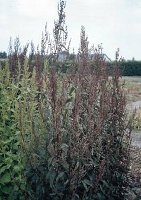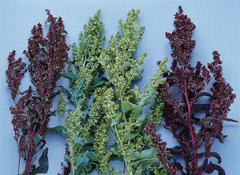 Red
Plume
- Atriplex hortensis - Annual - Accent or
cut flower with tall
plumes. For best appearance in arrangements, pinch off
the bottom
leaves. Partial or full sun Height: 72 inches
Red
Plume
- Atriplex hortensis - Annual - Accent or
cut flower with tall
plumes. For best appearance in arrangements, pinch off
the bottom
leaves. Partial or full sun Height: 72 inches
| HOME --> All Plants and Seeds INDEX --> Vegetables INDEX --> Atriplex | |
| Plant and Seed Mobile Friendly Index |
Atriplex hortensis, also known as Mountain Spinach or Orache is an annual plant related to Chenopodium and is a member of the family Chenopodiaceae. Grown as a leafy vegetable, some varieties also make very attractive additions to the flower garden. Vegetable orach is prized for its vitamin E content and is often fed to grazing animals to boost the healthiness of their meat. Atriplex varieties have also been used extensively to reclaim mining sites, as the roots are fibrous and they help to minimize erosion.
Atriplex hortensis may be grown most easily from seed. Seeds should be sown in pots, trays or a bed prepared with a medium of 1 part sphagnum peat to 1 part sand. They should be covered lightly and kept moist, but not soggy at about 70F. When seedlings are about 2 inches in height, they can be transplanted to larger containers or directly to the garden, if the temperatures do not fall below 65F
The following types, ATRIPLEX CANESCENS(Four-wing Saltbush), ATRIPLEX CONFERTIFOLIA(Shadscale), ATRIPLEX CUENATA(Castle Valley Saltbush), ATRIPLEX LENTIFORMIS(Quail Bush), ATRIPLEX NUTTALLII or ATRIPLEX GARDNERI, ATRIPLEX POLYCARPA(Desert Saltbush), ATRIPLEX SPINIFERA(Mojave Saltbush), and ATRIPLEX TRIDENTATA(Trident Saltbush) seed should be naturally stratified or artificially cold stratified for 60 days prior to sowing.
COLD STRATIFICATION Natural stratification is achieved by planting the seed in a prepared bed outdoors in late fall, where rain, snow and freezing temperatures will allow the seed to germinate. Artificial stratification is done for convenience. We have discovered the following method of cold artificial stratification work best:
Soak the seed for 24 hours in warm water. Drain the water. Get a handful of sphagnum peat, vermiculite or other sterile moisture medium and place it in a sealable plastic bag. (Sphagnum peat is best for stratification as it contains anti-fungal properties.) Add enough water to thoroughly moisten the peat moss and allow it to rest for a couple of hours to soak up the water, then hold the bag upside down and squeeze any excess water out of the peat moss. Add the seed to the bag and shake to mix. Place the bag in a refigerator at 34 to 41 degrees F. (Placing the bag in an unheated outbuilding or garage will work as long as the temperature does not exceed 41 degrees F.)
Check the bag about once a week. If you notice any mold forming inside the bag, remove the molded seed and throw them away. If the moisture mix appears to be dry, add enough water to moisten it and squeeze out any excess water, then re-seal the bag. Check the next day to make certain that no water is standing in the bag. If so, pour it out. If you notice any seeds sprouting, remove them and plant them.
Most tree seeds require the recommended treatments only
once. Do not
cold stratify a seed and then fall sow. Once the
initial stratification
is complete the seed is ready to germinate. If the outdoor temperature
warms, the seed will germinate and then may be killed by the freezing
temperatures of winter. In addition, once the seed has completed
stratification, it is ready to start growing. In this state the seed
will use up its energy reserves at a rapid rate and will have a much
reduced shelf life at warmer or cooler temperatures.
(see also: NATURAL SEED
STRATIFICATION, WARM
STRATIFICATION, COLD STRATIFICATION)
Flowering Types
 Red
Plume
- Atriplex hortensis - Annual - Accent or
cut flower with tall
plumes. For best appearance in arrangements, pinch off
the bottom
leaves. Partial or full sun Height: 72 inches
Red
Plume
- Atriplex hortensis - Annual - Accent or
cut flower with tall
plumes. For best appearance in arrangements, pinch off
the bottom
leaves. Partial or full sun Height: 72 inches
| #5521 Packet $3.50 Approximately 100 seeds |
|
 Green
Plume - Atriplex hortensis - Annual - Tall
green plumes. Partial or
full sun Height: 72 inches
Green
Plume - Atriplex hortensis - Annual - Tall
green plumes. Partial or
full sun Height: 72 inches
| #5520 Packet $3.50 Approximately 100 seeds |
|
Plume Mixed Colors - Atriplex hortensis - Annual - Mix of green and red plumes. Partial or full sun Height: 72 inches
| #5522 Packet $3.50 Approximately 100 seeds |
|
Shrubby Types
ATRIPLEX CANESCENS(Four-wing Saltbush, Chamiso, Chamiza, Grey Sagebrush)- Native shrub to the western United States, this shrub prefers sandy well drained soils. Leaves are edible, with a salty taste. They can be boiled to produce a mild soap that native Americans have used to soothe bee stings. The seeds can be dried and burnt and the ashes used as a baking soda substitute. The shrub is small, heavily branched covered with fine grey green leaves. Plants tend to die at the center and spread outward from the crown. Partial or full shade Height: 6 inches Hardy to -40F (-40C)
| #1648 Packet $17.50 Approximately 50 seeds |
|
ATRIPLEX CONFERTIFOLIA(Shadscale) - Large shrub native to the United States southwest having a dense growth habit and producing small grey green leaves and winged fruits. It is most often found growing wild in the edges of groves of larger trees in well drained sandy soil. The leaves are eaten as greens and the seed ground and used as flour, or as an ingredient in pinole. Partial or full sun Height: 70 inches Hardy to -10F (-17.7C)
| #1649 Packet $17.50 Approximately 50 seeds |
|
ORDER EARLY!
See TERMS
Back to VARIETY INDEX Terms
HOME
![]() If
you have arrived in someone else's frame, or can not see all of the
other
information available on richfarmgarden.com Click on logo to enter from
beginning
If
you have arrived in someone else's frame, or can not see all of the
other
information available on richfarmgarden.com Click on logo to enter from
beginning